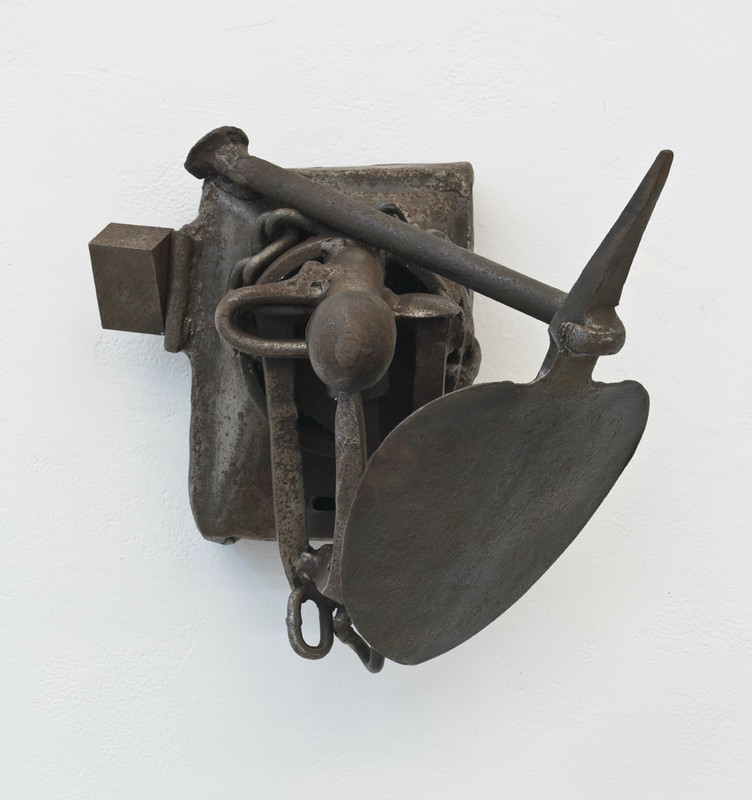Melvin Edwards
11 Jan - 12 Apr 2014
MELVIN EDWARDS
11 January – 12 April 2014
The Anne de Villepoix gallery is presenting for the first time the work of artist Melvin Edwards with pieces best known, Lynch fragments .
Melvin Edwards is a pioneer in the history of contemporary African-American art and sculpture. Born in Houston, Texas in 1937 , he began his artistic career at the University of Southern California, where he met and was mentored by Hungarian painter Francis de Erdely. In 1965 the Santa Barbara Museum of Art organized Edwards’ first solo exhibition, which launched his professional career. He moved to New York City in 1967, where shortly after his arrival, his work was exhibited at the then newly created Studio Museum, and in 1970 became the first African-American sculptor to have works presented in a solo exhibition at the Whitney Museum.
Edwards’ work reflects his engagement with the history of race, labor, violence, as well as with themes of African diaspora. Making welding his preferred medium, his compositions are studies in abstraction and minimalism. Edwards creates sculptures forging together metal objects such as tools, knives, hooks, and machine parts, to construct objects distinguished by formal simplicity and sturdy materiality.
Edwards is famous for his sculptural series Lynch Fragments (presented here), which spans three periods: the early 1960s, when he responded to racial violence in the United States; the early 1970s, when his activism concerning the Vietnam War motivated him to return to the series; and from 1978 to the present, when he turned to the Lynch Fragments as a vehicle to honor individuals and explore nostalgia. Edwards has felt deeply connected to Africa since the 1970s, when he and his late wife, poet Jayne Cortez, began visiting the continent. He taught metalworking in several countries, establishing workshops and mentoring a younger generation of African welders. Through the decades Edwards’ Lynch Fragments series has embodied his relation to African culture and artifacts. Most notably, African masks became a source of inspiration to the artist revealing both in the formal configuration and titles of the fragments.
His work has been widely exhibited and is represented in the collections of the MOMA, Studio Harlem, Brooklyn Museum and the Metropolitan in New York.
In 1993 the Neuberger Museum of Art in Purchase, NY, organized the first retrospective in Edwards’ career documenting his thirty-year artistic development. The Nasher Sculpture in Dallas, TX is organizing a second retrospective featuring his work from the early 1960s to the present to open in 2015
11 January – 12 April 2014
The Anne de Villepoix gallery is presenting for the first time the work of artist Melvin Edwards with pieces best known, Lynch fragments .
Melvin Edwards is a pioneer in the history of contemporary African-American art and sculpture. Born in Houston, Texas in 1937 , he began his artistic career at the University of Southern California, where he met and was mentored by Hungarian painter Francis de Erdely. In 1965 the Santa Barbara Museum of Art organized Edwards’ first solo exhibition, which launched his professional career. He moved to New York City in 1967, where shortly after his arrival, his work was exhibited at the then newly created Studio Museum, and in 1970 became the first African-American sculptor to have works presented in a solo exhibition at the Whitney Museum.
Edwards’ work reflects his engagement with the history of race, labor, violence, as well as with themes of African diaspora. Making welding his preferred medium, his compositions are studies in abstraction and minimalism. Edwards creates sculptures forging together metal objects such as tools, knives, hooks, and machine parts, to construct objects distinguished by formal simplicity and sturdy materiality.
Edwards is famous for his sculptural series Lynch Fragments (presented here), which spans three periods: the early 1960s, when he responded to racial violence in the United States; the early 1970s, when his activism concerning the Vietnam War motivated him to return to the series; and from 1978 to the present, when he turned to the Lynch Fragments as a vehicle to honor individuals and explore nostalgia. Edwards has felt deeply connected to Africa since the 1970s, when he and his late wife, poet Jayne Cortez, began visiting the continent. He taught metalworking in several countries, establishing workshops and mentoring a younger generation of African welders. Through the decades Edwards’ Lynch Fragments series has embodied his relation to African culture and artifacts. Most notably, African masks became a source of inspiration to the artist revealing both in the formal configuration and titles of the fragments.
His work has been widely exhibited and is represented in the collections of the MOMA, Studio Harlem, Brooklyn Museum and the Metropolitan in New York.
In 1993 the Neuberger Museum of Art in Purchase, NY, organized the first retrospective in Edwards’ career documenting his thirty-year artistic development. The Nasher Sculpture in Dallas, TX is organizing a second retrospective featuring his work from the early 1960s to the present to open in 2015

